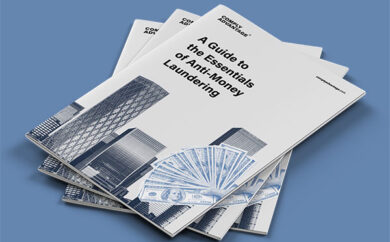

Money laundering and terrorist financing (ML/TF) pose a substantial threat to governments and financial institutions. Over the past few decades, increasing measures have been taken across the globe to counter them.
In 2022, the EU moved forward in its bid to create a dedicated Anti-Money Laundering Authority (AMLA), joining other nations and international bodies in updating their policies to coordinate their AML/CFT efforts.
So, what is anti-money laundering (AML)? It refers to the policies and legislation that compel financial institutions to monitor their clients to prevent money laundering. AML laws require firms to report any financial crime they detect to law enforcement to crack down on criminals feeding illicit funds into the financial system.
Anti-money laundering and the FATF
In 1989, the Financial Action Task Force (FATF) was created by the G7 group of nations in response to mounting concern over the threat posed to international banking systems and financial institutions by money laundering.
The FATF is responsible for the formation of most international AML standards. Less than a year after its creation, it issued a report containing its 40 Recommendations, which has become a global, comprehensive framework for fighting money laundering.
The FATF subsequently began identifying countries that did not have adequate legislation regarding money laundering. This ‘name and shame’ tactic helped motivate governments to alter their legislation and enforce its recommendations.
From 16 members in 1991, the FATF has expanded to its current 39 members (37 countries plus the European Commission and Gulf Cooperation Council).
Anti-money laundering in banking
Financial institutions play a pivotal role in financial crime, so they must be adequately trained to identify and handle money laundering. Almost every bank employee receives AML training and is legally required to report suspicious activity.
However, much media attention has focused on AML deficiencies in large, traditional banks. The USAA Federal Savings Bank was fined $140m after admitting it willfully failed to implement and maintain an AML program that met minimum requirements – despite repeated warnings.
The case shows that while many banks of this size invest considerable sums in their AML programs, they still struggle to monitor criminal activity properly. Unlike challenger and digital banks, established firms must adapt their existing structures to new, automated tools – and the staffing requirements that come with them. However, the transition is key to meeting regulatory requirements and adopting a risk-based approach.
Anti-money laundering in digital banking
Even high-profile digital banks have been called out for major AML breaches. For example, German regulator BaFin has twice warned N26 about lax AML controls and ordered the bank to “rectify deficiencies in IT monitoring and due diligence.”
The biggest challenge to AML in digital banks is scaling too quickly and the subsequent pressure to onboard customers in a short space of time. Remediation work is needed if bad actors are identified once onboarded.
Key AML considerations for digital banks should include:
- Embedding KYC – including customer due diligence – as an essential component of a more comprehensive risk strategy, not a one-off process
- Implementing effective, real-time transaction monitoring
- Swift, accurate suspicious activity reporting
- Training front-line and compliance staff on the latest criminal methodologies and behaviors
- Using analytics to facilitate compliant and accurate evaluations – e.g., to ascertain that alert thresholds are calibrated adequately
Anti-money laundering in crypto
While crypto laundering is a relatively new methodology, regulators globally are stepping up crypto asset AML measures.
In the US, FinCEN has set out dedicated KYC AML measures for cryptocurrency service providers; and in Singapore, the MAS Omnibus Act imposes AML/CFT controls on cryptocurrency service providers. In Europe, the Markets in Crypto-assets (MiCA) Regulation is making its way through the European Parliament and will provide a legal framework for crypto assets.
Following FATF guidance to implement a risk-based approach, crypto service providers should ensure:
- Customer due diligence – including digital identity verification
- Transaction monitoring – automated monitoring technology can help capture and triage necessary data
- PEP screening – regularly review customers’ PEP status
- Sanctions screening – using relevant international sanctions lists from a provider that updates its sources in real-time
- Adverse media screening – screening print sources as well as digital outlets

Request a Demo Of Our AML Solutions
See how our AML tools can help with anti money laundering in your organization.
Get StartedAnti-money laundering and DNFBPs
Where and how to cover designated non-financial businesses and professions (DNFBPs) – non-financial sector businesses that pose an ML/FT risk – in AML regulations is an ongoing debate in many countries. What isn’t in doubt is the role many of these firms can play in enabling money laundering.
Defense think tank RUSI has warned that a lack of guidance around DNFBPs is increasing the risk of North Korea evading targeted sanctions and recommends that AML regulations better reflect this risk.
Australian regulator AUSTRAC is prosecuting the country’s largest casino operator, Crown Resorts, over “serious and system non-compliance” with AML laws. But while the regulator has provided guidance on preparing and implementing AML/CFT for the pubs and clubs sector, Australia has been accused of “dragging its feet” over regulating DNFBPs for AML more widely.
Meanwhile, Hong Kong is introducing a licensing program for precious metal dealers. This addresses a concern raised by the FATF in its 2018 evaluation that the exemption of dealers in precious metals or stones (DPMS) from AML/CFT rules “is not based on proven low risk.” It recommended the government introduce the “appropriate level of AML/CFT requirements for the DPMS sector regarding ML/TF risks.”
FATF recommends that DNFBPs are subject to the same risk-based AML/CFT compliance regulations as banks and other financial institutions, including transaction monitoring, reporting, and record-keeping obligations. The guidance requires jurisdictional authorities to take a range of supervisory steps, including:
- Implementing licensing requirements and ownership criteria for casinos
- Introducing effective monitoring systems
- Preventing criminals and their associates from owning or controlling DNFBPs
- Implementing proportionate and dissuasive sanctions to deal with compliance violations
Anti-money laundering technology
Anti-money laundering software platforms help financial institutions implement their AML programs across data management and procedural filtering, predictive analysis, and machine learning.
Platforms can also monitor and flag large-scale suspect activities involving high-value assets or smaller, individual transactions.
While platforms vary in what they offer, AML software falls into four main categories:
- Name screening: AML software can be used to quickly identify blocked/sanctioned persons and flag them to an institution. Screening should also include PEPs and adverse media – negative news found across a wide variety of sources that shows an increased risk in conducting business with the person discussed
- Transaction monitoring: This AML software focuses on monitoring and identifying suspicious patterns in customer transactions, using historical information and the specifics of certain account profiles
- Currency Transaction Reporting (CTR): AML software used to spot transactions involving large amounts of cash or multiple small transactions aggregating a large amount of cash
- Compliance: AML software used in the day-to-day implementation of compliance requirements, including employee training, scheduled audits, and track reports submitted to financial authorities
Hiring an anti-money laundering compliance team
However, technology alone isn’t sufficient for AML programs – the right talent is needed to implement systems, monitor alerts, make decisions on high-risk cases and file suspicious activity reports (SARs). But skill/labor shortages mean firms have to work harder than ever to attract top talent, particularly if they are looking to hire from banks.
When choosing new hires, firms need to consider whether they need generalists or specialists, the type of experience required, and the cultural fit. As more processes are automated, firms may focus more on senior and specialist staff.
Training an anti-money laundering compliance team
Periodic training – and regular refreshes – should help ensure the risk-based approach is followed consistently by firms and that all staff are up-to-date on the latest internal processes, risk categories, and relevant regulations.
Beyond a regular, disciplined training roster, compliance teams also need to be agile. New risks can emerge quickly and ad hoc training to accommodate unique scenarios is critical. Post-scenario analysis sessions can also help teams assess the effectiveness of their response and how they can identify similar scenarios in the future.
AML for Fintechs
Are you an early stage FinTech and need an AML solution? Discover ComplyLaunch™, our automated solutions package.
Get StartedOriginally published 22 June 2014, updated 22 January 2025
Disclaimer: This is for general information only. The information presented does not constitute legal advice. ComplyAdvantage accepts no responsibility for any information contained herein and disclaims and excludes any liability in respect of the contents or for action taken based on this information.
Copyright © 2025 IVXS UK Limited (trading as ComplyAdvantage).
